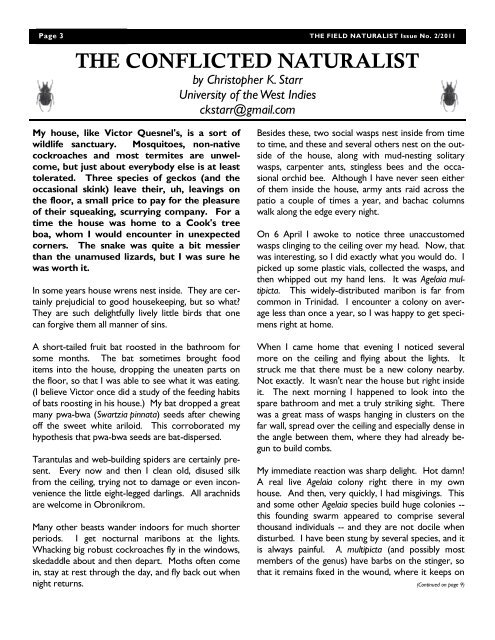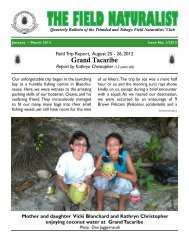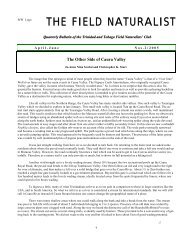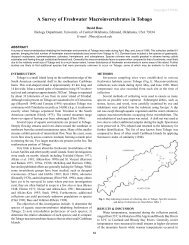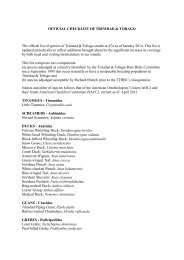Moruga Bouffe - The Trinidad and Tobago Field Naturalists' Club
Moruga Bouffe - The Trinidad and Tobago Field Naturalists' Club
Moruga Bouffe - The Trinidad and Tobago Field Naturalists' Club
Create successful ePaper yourself
Turn your PDF publications into a flip-book with our unique Google optimized e-Paper software.
Page 3 THE FIELD NATURALIST Issue No. 2/2011THE CONFLICTED NATURALISTby Christopher K. StarrUniversity of the West Indiesckstarr@gmail.comMy house, like Victor Quesnel's, is a sort ofwildlife sanctuary. Mosquitoes, non-nativecockroaches <strong>and</strong> most termites are unwelcome,but just about everybody else is at leasttolerated. Three species of geckos (<strong>and</strong> theoccasional skink) leave their, uh, leavings onthe floor, a small price to pay for the pleasureof their squeaking, scurrying company. For atime the house was home to a Cook's treeboa, whom I would encounter in unexpectedcorners. <strong>The</strong> snake was quite a bit messierthan the unamused lizards, but I was sure hewas worth it.In some years house wrens nest inside. <strong>The</strong>y are certainlyprejudicial to good housekeeping, but so what?<strong>The</strong>y are such delightfully lively little birds that onecan forgive them all manner of sins.A short-tailed fruit bat roosted in the bathroom forsome months. <strong>The</strong> bat sometimes brought fooditems into the house, dropping the uneaten parts onthe floor, so that I was able to see what it was eating.(I believe Victor once did a study of the feeding habitsof bats roosting in his house.) My bat dropped a greatmany pwa-bwa (Swartzia pinnata) seeds after chewingoff the sweet white ariloid. This corroborated myhypothesis that pwa-bwa seeds are bat-dispersed.Tarantulas <strong>and</strong> web-building spiders are certainly present.Every now <strong>and</strong> then I clean old, disused silkfrom the ceiling, trying not to damage or even inconveniencethe little eight-legged darlings. All arachnidsare welcome in Obronikrom.Many other beasts w<strong>and</strong>er indoors for much shorterperiods. I get nocturnal maribons at the lights.Whacking big robust cockroaches fly in the windows,skedaddle about <strong>and</strong> then depart. Moths often comein, stay at rest through the day, <strong>and</strong> fly back out whennight returns.Besides these, two social wasps nest inside from timeto time, <strong>and</strong> these <strong>and</strong> several others nest on the outsideof the house, along with mud-nesting solitarywasps, carpenter ants, stingless bees <strong>and</strong> the occasionalorchid bee. Although I have never seen eitherof them inside the house, army ants raid across thepatio a couple of times a year, <strong>and</strong> bachac columnswalk along the edge every night.On 6 April I awoke to notice three unaccustomedwasps clinging to the ceiling over my head. Now, thatwas interesting, so I did exactly what you would do. Ipicked up some plastic vials, collected the wasps, <strong>and</strong>then whipped out my h<strong>and</strong> lens. It was Agelaia multipicta.This widely-distributed maribon is far fromcommon in <strong>Trinidad</strong>. I encounter a colony on averageless than once a year, so I was happy to get specimensright at home.When I came home that evening I noticed severalmore on the ceiling <strong>and</strong> flying about the lights. Itstruck me that there must be a new colony nearby.Not exactly. It wasn't near the house but right insideit. <strong>The</strong> next morning I happened to look into thespare bathroom <strong>and</strong> met a truly striking sight. <strong>The</strong>rewas a great mass of wasps hanging in clusters on thefar wall, spread over the ceiling <strong>and</strong> especially dense inthe angle between them, where they had already begunto build combs.My immediate reaction was sharp delight. Hot damn!A real live Agelaia colony right there in my ownhouse. And then, very quickly, I had misgivings. This<strong>and</strong> some other Agelaia species build huge colonies --this founding swarm appeared to comprise severalthous<strong>and</strong> individuals -- <strong>and</strong> they are not docile whendisturbed. I have been stung by several species, <strong>and</strong> itis always painful. A. multipicta (<strong>and</strong> possibly mostmembers of the genus) have barbs on the stinger, sothat it remains fixed in the wound, where it keeps on(Continued on page 9)


